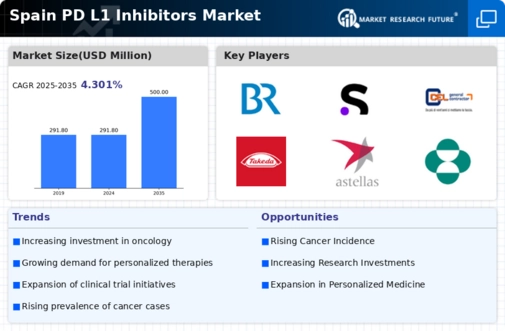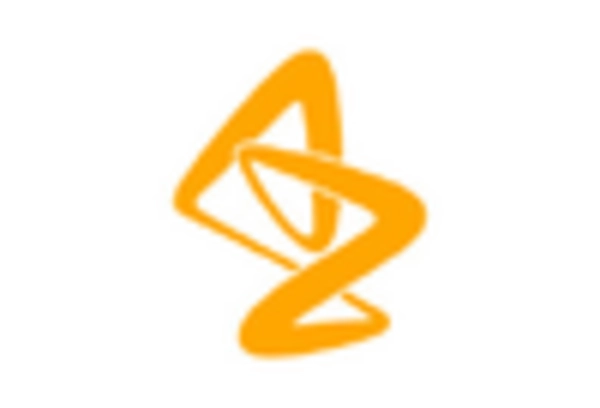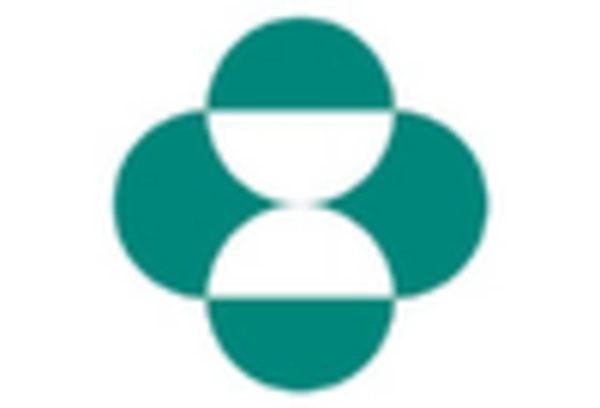Increasing Cancer Incidence
The rising incidence of various cancers in Spain is a primary driver for the pd l1-inhibitors market. According to recent statistics, cancer cases are projected to increase by approximately 20% over the next decade. This alarming trend necessitates the development and adoption of innovative therapies, including pd l1-inhibitors, which have shown promise in enhancing patient outcomes. As healthcare providers seek effective treatment options, the demand for pd l1-inhibitors is likely to grow. Furthermore, the Spanish healthcare system is increasingly prioritizing oncology treatments, which may lead to greater investment in research and development of these therapies. Consequently, the increasing cancer incidence in Spain is expected to significantly impact the growth trajectory of the pd l1-inhibitors market.
Growing Awareness and Education
There is a notable increase in awareness and education regarding cancer treatments among healthcare professionals and patients in Spain. Initiatives aimed at educating oncologists about the benefits of pd l1-inhibitors are gaining traction, which may lead to higher prescription rates. Surveys indicate that approximately 70% of oncologists in Spain are now familiar with the mechanisms and advantages of pd l1-inhibitors. This growing knowledge base is crucial for the adoption of these therapies, as informed healthcare providers are more likely to recommend them to patients. Consequently, the heightened awareness and education surrounding pd l1-inhibitors are expected to drive market growth in Spain.
Supportive Regulatory Environment
The regulatory environment in Spain is becoming increasingly supportive of innovative cancer therapies, including pd l1-inhibitors. The Spanish Agency of Medicines and Medical Devices (AEMPS) has streamlined the approval process for new oncology drugs, reducing the time required for market entry. This regulatory flexibility encourages pharmaceutical companies to invest in the development of pd l1-inhibitors, as they can bring their products to market more efficiently. Additionally, the AEMPS has implemented programs to expedite the review of promising therapies, which may further enhance the competitiveness of the pd l1-inhibitors market. As a result, the supportive regulatory environment is likely to facilitate the growth of this market in Spain.
Advancements in Research and Development
Ongoing advancements in research and development within the pharmaceutical sector are propelling the pd l1-inhibitors market forward. Spain has established itself as a hub for innovative cancer research, with numerous clinical trials focusing on pd l1-inhibitors. The Spanish government has allocated substantial funding, estimated at €200 million annually, to support cancer research initiatives. This financial backing fosters collaboration between academic institutions and pharmaceutical companies, leading to the discovery of novel therapies. As a result, the pd l1-inhibitors market is likely to benefit from a steady influx of new products and treatment options, enhancing the overall landscape of cancer care in Spain.
Increasing Investment in Healthcare Infrastructure
Investment in healthcare infrastructure in Spain is on the rise, which is likely to benefit the pd l1-inhibitors market. The Spanish government has committed to increasing healthcare spending by 5% annually, with a focus on enhancing cancer treatment facilities and technologies. This investment is expected to improve access to advanced therapies, including pd l1-inhibitors, for patients across the country. Furthermore, the establishment of specialized cancer treatment centers is anticipated to provide a conducive environment for the administration of these therapies. As healthcare infrastructure continues to improve, the pd l1-inhibitors market is poised for growth, driven by enhanced accessibility and treatment capabilities.

















Leave a Comment